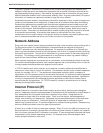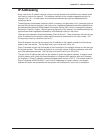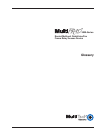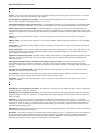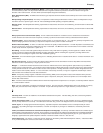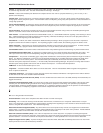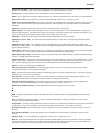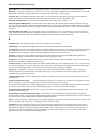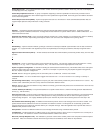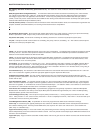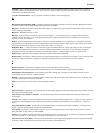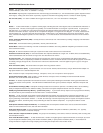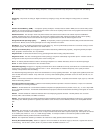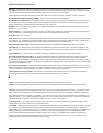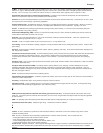
86
MultiFRAD 3000-Series User Guide
Excess Zeros: A T1 error condition that is logged when more than 15 consecutive 0s or less than one 1 bit in 16 bits occurs.
Exchange: A unit (public or private) that can consist of one or more central offices established to serve a specified area. An exchange
typically has a single rate of charges (tariffs) that has previously been approved by a regulatory group.
Exchange Area: A geographical area with a single uniform set of charges (tariffs), approved by a regulatory group, for telephone
services. Calls between any two points within an exchange area are local calls. See also "Digital PBX", "PBX".
Exchange Termination (ET): The carrier's local exchange switch. Contrast with "Loop Termination - LT".
Explicit Congestion Management: The method used in frame relay to notify the terminal equipment that the network is overly busy.
The use of FECN and BECN is called explicit congestion management. Some end-to-end protocols use FECN or BECN, but usually not
both options together. With this method, a congestion condition is identified and fixed before it becomes critical. Contrast with "implicit
congesion".
Extended Super Frame (ESF): One of two popular formats for framing bits on a T1 line. ESF framing has a 24-frame super-frame,
where robbed bit signaling is inserted in the LSB (bit 8 of the DS-0 byte) of frames 6, 12, 18 and 24. ESF has more T1 error measure-
ment capabilities than D4 framing. ESF and B8ZS are typically both offered to provide clear channel service.
F
Failed Seconds: A test parameter where the circuit is unavailable for one full second.
Failed Signal: A T1 test parameter logged when there are more than 9 SES (Severely Errored Seconds).
Fax (facsimile): Refers to the bit-mapped rendition of a graphics-oriented document (fax) or to the electronic transmission of the image
over telephone lines (faxing). Fax transmission differs from data transmission in that the former is a bit-mapped approximation of a
graphical document and, therefore, cannot be accurately interpreted according to any character code.
Firmware: A category of memory chips that hold their content without electrical power, they include ROM, PROM, EPROM and
EEPROM technologies. Firmware becomes "hard software" when holding program code.
Foreground: The application program currently running on and in control of the PC screen and keyboard. The area of the screen that
occupies the active window. Compare with "background".
Fractional T1 (FT1): A digital data transmission rate between 56K bps (DS0 rate) and 1.544M bps (the full T1 rate - in North America).
FT1 is typically provided on 4-wire (two copper pairs) UTP. Often used for video conferencing, imaging and LAN interconnection due to
its low cost and relatively high speed. FT1 rates are offered in 64K bps multiples, usually up to 768K bps.
Frequency: A characteristic of an electrical or electronic signal which describes the periodic recurrence of cycles. Frequency is
inversely proportional to the wavelength or pulse width of the signal (i.e., long wavelength signals have low frequencies and short
wavelength signals yield high frequencies).
Foreign Exchange (FX): A CO trunk with access to a distant CO, allowing ease of access and flat-rate calls anywhere in the foreign
exchange area.
Foreign Exchange Office (FXO): provides local telephone service from a CO outside of ("foreign" to) the subscriber's exchange
area. In simple form, a user can pick up the phone in one city and receive a tone in the foreign city.
Connecting a POTS telephone to a computer telephony system via a T1 link requires a channel bank configured for the FX connection.
To generate a call from the POTS set to the computer telephony system, a FXO connection must be configured.
Foreign Exchange Station (FXS): See FX, FXO. To generate a call from the computer telephony system to the POTS set, a FXS
connection must be configured.
Forward Explicit Congestion Notification (FECN): A bit that tells you that a certain frame on a particular logical connection has
encountered heavy traffic. The bit provides notification that congestion-avoidance procedures should be initiated in the same direction of
the received frame. See also BECN (Backward Explicit Congestion Notification).
Frame: A group of data bits in a specific format to help network equipment recognize what the bits mean and how to process them. The
bits are sent serially, with a flag at each end signifying the start and end of the frame.
Frame Relay: A form of packet switching that uses small packets and that requires less error checking than other forms of packet
switching. Frame relay is effective for sending "bursty" data at high speeds (56/64K, 256K, and 1024K bps) over wide area networks.
Frame Relay specifications are defined by ANSI documents ANSI T1.602, T1.606, T1S1/90-175, T1S1/90-213, and T1S1/90-214. In
using frame relay, blocks of information (frames) are passed across a digital network interface using a "connection number" that is
applied to each frame to distinguish between individual frames.



